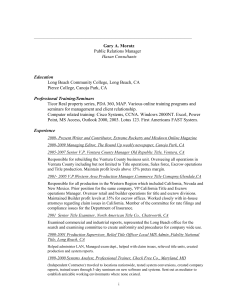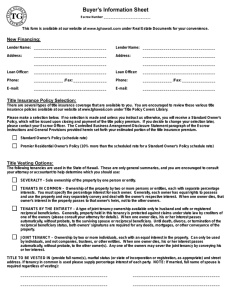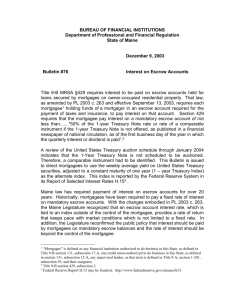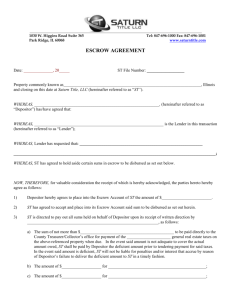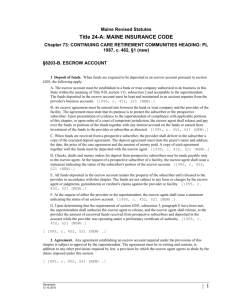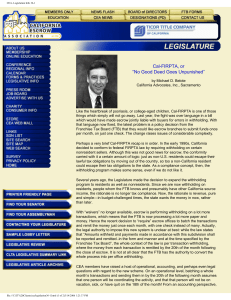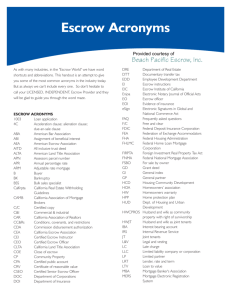escrow contracts
advertisement
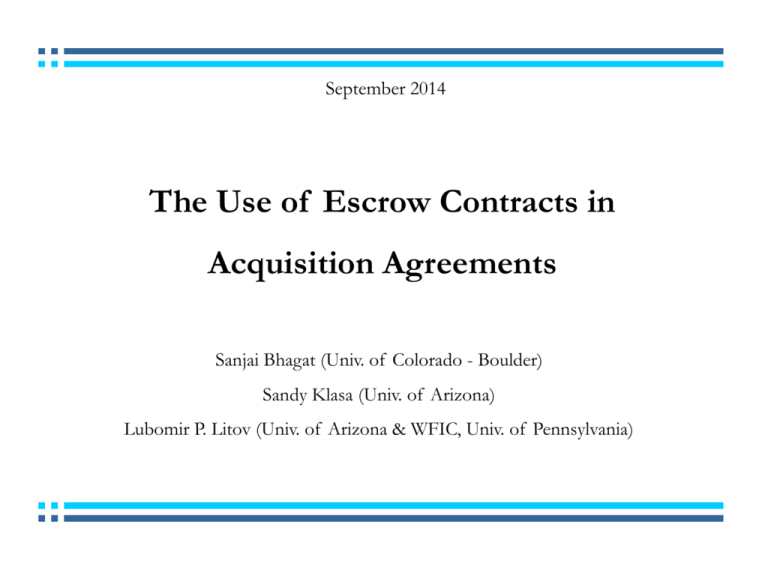
September 2014 The Use of Escrow Contracts in Acquisition Agreements Sanjai Bhagat (Univ. of Colorado - Boulder) Sandy Klasa (Univ. of Arizona) Lubomir P. Litov (Univ. of Arizona & WFIC, Univ. of Pennsylvania) Escrow Contracts in Acquisition Agreements - A form of contingent payment contract, where buyer and seller agree that seller will deposit a fraction of purchase price (usually 12.2% of it) into a treasury account for a certain period of time (usually 17.4 months). - Employed in private firm and subsidiary acquisitions but not used in acquisitions of publicly traded targets. - In our sample, escrow accounts used in 52.1% of all unlisted target deals. - More commonly used in (i) stock purchase acquisitions and (ii) acquisitions of stand-alone targets. 2 Institutional Detail Use of Escrow Contract Funds - EBITDA & Purchase Price Adjustments. - Working Capital Adjustments (A/R, A/P, Inventory, other current assets). - Environmental Liabilities. - Pending Litigation. - Obligations Related to Collective Bargaining Agreements. - Unpaid Taxes Due. - Certain Other Non-Fraudulent Breach of Representations & Warranties. Escrow Agreement Disputes Resolution - Binding Arbitration. - Non-binding Mediation. Escrow Agreements vs. Transaction Insurance - Insurance more expense, and limited in coverage. 3 Preliminary Sample Statistics All Deals Sample Variable Percent of Deals with an Escrow Agreement All Sample (943 obs.) 52.1% Deal with Escrow Contract Escrow Contract (491 obs.) Variable Percent Deposited Through an Escrow Agreement Average Escrow Agreement Size (US$ m) Average Escrow Agreement Duration (Months) Percent of deals with: % Stock Purchases % Asset Purchases % Stand-alone Targets % Subsidiary Targets All 73.7% 26.3% 60.30% 39.70% Sample with Escrow Contracts 80.0% 20.0% 75.60% 24.40% 12.2% $11.7 17.4 Sample without Escrow Contracts 66.8% 33.2% 43.80% 56.20% 4 Example - Syntax-Brillian & Vivitar Stock-for-stock Merger; - Escrow Agreement Duration: 12 months; Escrow Agreement Size: 15% of transaction value; - Target Value: $26M; - SEC Docs: Link (seller) (escrow agent) (cap on liability) (claims process) 5 Hypotheses Main Hypothesis The use of escrow contracts in unlisted target acquisitions is an efficient contracting mechanism that: 1) Facilitates completion of these acquisitions by allowing buyers & sellers to manage acquisition-related transaction risks, and 2) Allow parties to overcome information asymmetry problems. 6 Hypotheses Several implications of the main research hypothesis follow through. Use of Escrow Contracts - Transaction Risk Predictions - Stand-alone targets are likelier to use escrow contract. - Subsidiary targets less likely to use escrow contract. - Larger targets (relative to acquirer) are likelier to use escrow contract. - Targets with dominant shareholders are likelier to use escrow contract (to manage joint & several liability if post-acquisition breach of reps. & warranties). - Stock purchases (as opposed to asset purchases) are likelier to use escrow contract. 7 Hypotheses Use of Escrow Contracts - Informational Asymmetry Risk Predictions - Different industry acquisitions likelier to use escrow contract. - Targets w/ higher degree of earnings management likelier to use escrow contract. - Targets in industries w/ higher earnings volatility likelier to use escrow contract. - Targets in industries w/ lower analyst coverage likelier to use escrow contract. - Distressed targets (i.e., w/ lower interest coverage) likelier to use escrow contract. Use of Escrow Contracts – Other Risks Predictions - Escrow contracts are used if reverse insurance, in the form of liability cap limitations (or caps) is included (caps are on average 2.4 times escrow size). 8 Main Findings Escrow agreements are more common when transaction risk is high, i.e., for: - Stand-alone private targets, targets with dominant shareholders, larger targets (relative to acquirer). - Escrow contract use shortens time-to-complete transaction by 35.5-51.0%. Escrow agreements are more common if information asymmetry risk is high, i.e., for: - Targets in cross-industry acquisitions, targets w/ high accruals, targets in industries w/ high earnings volatility or low analyst coverage, targets that are financially constrained. Escrow agreements are more common when other risks may be present, i.e.: - If no reverse insurance in form of liability cap limitations (or caps) is included. 9 Main Findings Escrow contracts are associated with significantly smaller target discount: - Adoption of escrow agreement increases valuation of a private target (price-to-sales multiple compared to similar public target) by 3.5-6.1%. - Valuation impact stronger for stand-alone targets (7.4-9.1%) and weaker for subsidiary targets (0.8-2.2%). Escrow contracts benefit bidder: - For every dollar in escrow contract deposit, market capitalization to bidder shareholders is increased by 89 cents. - Bidder benefits from reduced losses (due to unrecorded or uncovered target liabilities), reduced information gathering (due diligence) costs, and reduced litigation costs (in case of dispute with target after closing). 10 Prior Literature Contingent payments Limited literature on contingent payments in private target acquisitions: - Anecdotal evidence in Deal Points studies, 2008-2012 (by American Bar Association). More academic research for such payments in public target acquisitions: - Stock payments - Officer, Poulsen, & Stegemoller (2009). - Earnouts - Kohers & Ang (2000); Datar, Frankel & Wolfson (2001); Cain, Denis & Denis (2011). - However, escrow contracts & earnouts usually address different frictions. - Other - Officer (2004) – collars. - Burch (1996) – lock-up provisions. - Bates & Lemmon (2005) – termination fees. Private Target Discount Officer (2007) – unlisted target discount & liquidity. 11 Data Collect Data from a novel database Business Valuation Resources LLC data. - Information on private target financials from 8K, DEF 14A, 10Q, & 10K. Collect data on 943 acquisitions: - Involve private target & public acquirer. - Target value above $25 million. - Completed 1994-2009. - Available information on target financials & consideration structure. We hand collect data on the presence of escrow contracts, caps, & earn outs. Collect data on size, maturity & type of consideration offered in escrow contract. Other: exclusive access to J.P. Morgan Chase escrow services client proprietary data. 12 Univariate Sample Statistics Table I. Panel A. Escrow Contracts and Target Price Discount Characteristics. All Deals Sample Variable Percent of Deals with an Escrow Agreement Average Time to Completion All Sample (943 obs.) 52.1% 57.5 days Deal with Escrow Contract Variable % Deposited Through Escrow Contract Escrow Contract Size (US$ m) Escrow Contract Duration (Months) Escrow Contract (491 obs.) 12.2% $11.7 17.4 Stand-alone Targets (371 obs.) 13.0% $11.9 17.5 Subsidiary Targets (120 obs.) 8.9% $11.0 17.1 Unlisted Target Price Discount (Means) Discount All Targets -0.243 Stand-alone Private Targets -0.171 Subsidiary Targets -0.333 Targets With Escrow Contract -0.196 Targets Without Escrow Contract -0.289 13 Univariate Sample Statistics Table I. Panel B. Target Characteristics. All Sample Average Target Characteristics (Medians) Sample with Escrow Agreements Sample without Escrow Agreements (943 obs.) (491 obs.) (452 obs.) Target Net Sales (in U.S.$ million) 48.7 38.4 63.7 32.2 73.0 18.4% 2.90 0.14 0.04 24.6 68.1 17.8% 1.93 0.16 0.035 43.9 80.0 18.9% 3.89 0.12 0.04 Target Total Assets (in U.S.$ million) Actual Target Price (in U.S.$ million) Relative Target Size (to Acquirer) Target Interest Coverage Target ROE Target ROA 14 Use of Escrow Contracts and Other Deal Characteristics Table II. Panel A. Deal Characteristics. Percent of deals with: % with Dominant Owner % with Liability Cap % with Stock Payment Only % with Cash Payment Only % with Earnout Contract % with Installment Note All 36.70% 73.7% 9.0% 36.7% 12.2% 11.7% Sample with Escrow Contracts 48.30% 85.3% 11.2% 31.8% 13.8% 8.8% Sample without Escrow Contracts 24.10% 61.1% 6.6% 42.0% 10.4% 14.8% Table II, Panel B. Sub-sample Comparisons. Stock Purchase Stand-Alone Target Dominant Target Owner Use of Liability Cap Payment is Stock Only Payment is Cash Only Use of Earnout Contract Escrow Deals with row characteristics 60.5% 65.2% 68.5% 60.3% 64.7% 45.1% 59.1% Escrow Deals without row characteristics 43.5% 32.1% 42.5% 29.1% 50.8% 56.1% 52.1% 15 Target Industry Distribution (Table III) Code 1 2 3 4 5 6 7 8 9 10 11 12 13 14 15 16 17 18 19 20 21 22 23 24 25 26 27 Fama-French Industry Name Agriculture Food Products Candy & Soda Beer & Liquor Tobacco Products Toys & Recreation Entertainment Printing and Publishing Consumer Goods Clothing & Apparel Healthcare Medical Equipment Pharmaceutical Products Chemicals Rubber and Plastic Products Textiles Construction Materials Construction Steel Works, Etc. Fabricated Products Machinery Electrical Equipment Automobiles and Trucks Aircraft Shipbuilding, Railroad Equipment Defense Precious Metals % Deals w/ Escrow Agreement & Target in Industry 0.2 0.8 0.2 0.0 0.0 0.2 1.0 2.1 0.8 1.4 3.9 3.5 3.7 0.8 1.0 0.0 0.8 2.7 1.7 0.0 2.9 1.4 1.2 1.0 0.6 0.8 0.0 % Deals w/ Target in Industry 0.5 1.0 0.1 0.1 0.0 0.6 1.1 2.0 1.1 1.5 3.0 3.0 4.9 1.4 1.3 0.2 1.6 2.4 1.4 0.0 2.2 1.9 1.1 0.9 0.4 0.4 0.2 (continued) 16 Target Industry Distribution (Table III, continued) Code 28 29 30 31 32 33 34 35 36 37 38 39 40 41 42 43 44 45 46 47 48 49 Fama-French Industry Name Non-Metallic and Industrial Metal Mining Coal Petroleum and Natural Gas Utilities Telecommunication Personal Services Business Services* Computers Computer Software* Electronic Equipment* Measuring and Control Equipment Business Supplies Shipping Containers Transportation Wholesale Retail Restaurants, Hotels, Motels Banking Insurance Real Estate Financial Trading Other % Deals w/ Escrow Agreement & Target in Industry 0.0 0.2 2.3 0.2 3.7 1.7 10.3 2.9 19.1 8.0 3.7 0.8 0.0 2.1 4.1 2.5 1.2 0.8 0.6 0.2 1.9 0.8 % Deals w/ Target in Industry 0.1 0.1 2.2 0.6 3.5 1.2 10.5 2.5 13.9 8.5 3.4 0.8 0.2 2.2 4.5 3.5 1.2 1.2 1.5 0.3 2.6 1.3 17 Determinants of Escrow Contract Use in Unlisted Target Acquisitions (Table IV) (Probit Models) Use of Escrow Agreement All Stand-alone Subsidiary Targets Targets Targets *** 0.223 Variables: Target is Stand-alone Private Firm (t-stat) Indicator for Asset Sale Relative Size of Target to Acquirer (5.68) -0.017 (0.41) 0.019* (1.66) Top Quintile Earnings Volatility Target Industry Indicator Low Analyst Coverage Target Industry Indicator Target & Acquirer are in Different Industry 0.009** (2.04) 0.038* (1.79) 0.016** (2.48) Target Accruals 0.542** (2.15) Target Interest Coverage -0.079* Indicator for Target Dominant Shareholder 0.161*** Indicator for Use of Liability Caps 0.267*** (1.88) (4.51) C&I Loan Rate Spread Ln (Deal Value) (6.97) -0.005 (0.10) -0.046*** (2.78) % Deals Target Industry Using Escrow Contract 0.208* % Bidder Use of Hybrid Method of Payment 0.012* (1.68) (1.92) -0.03 (0.47) 0.021** (2.53) 0.086** (2.27) 0.043* (1.87) 0.041*** (2.95) 0.515* (1.71) -0.069** (2.00) 0.125*** (2.95) 0.312*** (5.53) -0.023 (0.36) -0.024 (1.06) 0.426** (2.23) 0.010** (2.08) -0.003 (0.05) 0.008 (1.18) 0.108 (1.20) 0.112** (2.12) 0.025 (0.43) 0.799* (1.82) -0.031 (1.58) 0.218*** (2.75) 0.228*** (3.70) -0.073 (0.73) -0.073*** (2.72) 0.046 (1.21) 0.047** (2.48) (continued) 18 Endogeneity & Instrumental Variables Choice Adoption of escrow contract is endogenous w.r.t. valuation. Need instruments that are both (i) relevant & (ii) exclusive to determine choice of escrow adoption. Two instruments: - Propensity of peer target industry group to use such contracts. - Bidder reputation to use hybrid securities (including escrow contracts). Verify validity of such instruments through series of tests: - Overidentification test (Sargan stat). - Underidentification tests (partial R-squared, F-stat excluded instruments). 19 Determinants of Escrow Contract Use in Unlisted Target Acquisitions (Table IV) Excluded Instruments: Industry proxy Escrow Use Reputation proxy Percent of Deals in Target Industry that Use Escrow Agreement in the Previous Year (t-stat) Indicator Previous Use of Hybrid Securities by Acquirer Observations Pseudo R-squared All Targets Stand-alone Targets Subsidiary Targets 0.208* (1.68) 0.426** (2.23) 0.046 (1.21) 0.012* (1.92) 0.010** (2.08) 0.047** (2.48) 837 520 317 0.205 0.278 0.358 20 Economic Significance of Estimates in Determinants Model Model of Escrow Contract Use Determinants Independent Variables: ∆ in Probability Main Determinants Indicator for Use of Caps Target is Stand-alone Private Firm 26.70% 22.30% Indicator for Presence of Dominant Shareholder 16.10% Low Analyst Coverage Target Industry Indicator 3.80% Target Accruals* 3.69% Target & Acquirer are in Different Industry 1.60% Top Quintile Earnings Volatility Target Industry Indicator 0.90% Target Relative Value* 0.64% Target Interest Coverage* -0.22% C&I Spread* -0.93% Indicator for Asset Sale -1.70% Ln (Target Value)* -7.05% Instrumental Variables % of Deals in Target Industry that Use Escrow Prior Year 4.65% Indicator if Bidder Uses a Hybrid Payment in Prior Year 1.20% 21 Due Diligence Costs Analysis Bidders use escrow accounts to diminish due diligence costs. No direct proxy for such costs. We proxy for due diligence costs by time-to-deal completion. - Due diligence costs proportionate to time-to-deal completion. We find supporting results using litigation propensity. - Due diligence costs may be direct or indirect. - Inexpensive due diligence may result in future losses & litigation. - We can use litigation as another proxy for such costs. Our findings support hypothesis that escrow contracts diminish due diligence costs. 22 Time-to-Deal Completion Analysis (Table V) All Targets OLS 2SLS *** -20.385 Independent Variables: Escrow Agreement Indicator (t-stat) (2.68) -53.841** Instrumented Escrow Agreement Indicator (2.57) Target is a Stand-alone Private Firm Acquisition is Considered an Asset Sale Relative Size of Target to Acquirer Top Quintile Earnings Volatility Target Industry Indicator Low Analyst Coverage Target Industry Indicator Target & Acquirer are in Different Industries Target Accruals Target Interest Coverage (scaled by 1,000) Indicator for Target Dominant Shareholder Indicator for Use of Liability Cap in Acquisition Commercial & Industrial Loan Rate Spread Ln (Deal Value) Observations Adjusted R-squared Stand-alone Targets OLS 2SLS * -18.714 (1.71) -40.173** (2.58) Subsidiary Targets OLS 2SLS ** -24.175 (1.99) -21.001** (2.36) 0.740 (0.08) 0.835 (0.08) 3.286 (0.55) 6.866** (2.45) 23.361** (2.32) 3.714*** (2.64) 12.088 (0.39) 35.997 (0.91) -3.554 (0.54) 8.968 (1.17) 6.572 (0.73) 11.238** (2.25) 15.811 (0.74) 0.874 (0.08) 5.677 (0.91) 8.904** (2.58) 28.635*** (2.77) 0.803 (1.13) 25.819 (0.41) 40.263 (0.89) -2.950 (0.18) 18.447 (0.75) 9.397 (0.92) 8.420 (1.21) 0.097 (0.01) 3.997 (0.47) 15.416* (1.76) 36.011*** (2.87) -0.801 (0.13) -23.223 (0.57) 65.249 (0.91) -11.566 (1.38) 11.587 (1.13) 27.010** (2.13) 5.916 (1.19) 2.414 (0.15) 6.273 (0.72) 18.900** (1.97) 39.560*** (2.75) 0.172 (0.03) -64.083 (1.04) 70.500 (0.93) -16.647 (1.19) -10.284 (0.45) 31.554** (2.14) 6.505 (1.36) 10.601 (0.91) -0.133 (0.01) -11.318 (0.78) 0.768 (0.05) 10.641* (1.82) 61.004 (1.04) 0.623 (0.06) 7.439 (0.53) 8.842 (0.78) -14.291 (0.98) 21.079*** (3.19) 8.838 (0.70) -3.071 (0.31) -14.321 (0.95) 2.102 (0.12) 1.210 (0.70) 31.847 (0.47) 6.413 (0.42) -16.441 (0.90) 0.454 (0.02) -7.426 (0.42) 23.665*** (2.86) 884 0.086 837 0.090 536 0.133 520 0.132 348 0.034 317 0.027 23 Unlisted Target Discount We select to study valuation impact for target based on deal-value-to-sales multiple. - Officer (2007) uses deal-value-to-EBITDA multiples. - We do not use such multiples because: * EBITDA could be <0 (for public bidder or private target). * EBITDA defined discretionary across private targets. We calculate discount as ratio of private target multiple to similar public target multiple (net of one). Matching of public to private target counterparts: - Same industry (2-digit SIC). - Within 20% difference ideal size. - Within 36-months window centered on acquisition announcement date. 24 Analysis of Unlisted Target Discount Table VI. Panel A. Escrow Agreement Indicator (t-stat) Instrumented Escrow Agreement Indicator All Targets OLS 2SLS 0.084** (2.30) 0.202*** (3.16) Target is a Stand-alone Private Firm Acquisition is Considered Asset Sale Relative Size of Target to Acquirer Target & Acquirer in Different Industries Top Quintile Earnings Volatility Target Industry Low Target Industry Analyst Coverage Method of Payment is Only Cash Commercial & Industrial Loan Rate Spread Ln (Deal Value) Observations Adjusted R-squared 0.159*** Stand-alone Targets OLS 2SLS 0.126** (2.35) 0.228*** (3.28) Subsidiary Targets OLS 2SLS 0.044* (1.65) 0.139*** (2.73) (4.00) 0.025 (0.63) -0.051*** (2.72) 0.070* (1.92) 0.197*** (3.82) 0.029 (0.69) -0.04** (2.26) 0.061 (1.60) 0.121* (1.94) 0.012 (0.18) 0.050 (0.95) 0.141** (2.16) 0.019 (0.29) 0.039 (0.71) -0.019 (0.34) -0.093*** (2.84) 0.088** (2.47) -0.009 (0.16) -0.069* (1.79) 0.056* (1.86) 0.121** (1.99) -0.133* (1.93) -0.011 (0.29) -0.019 (0.33) 0.042** (2.23) 0.133** (2.15) -0.130* (1.81) -0.014 (0.38) -0.019 (0.33) 0.039* (1.85) 0.187** (2.10) -0.066 (0.70) -0.038 (1.63) -0.019 (0.24) 0.044 (1.52) 0.177** (1.97) -0.096 (1.00) -0.039 (1.61) -0.046 (0.56) 0.039 (1.32) 0.060 (0.67) -0.203* (1.84) 0.028 (0.52) -0.013 (0.15) 0.046* (1.76) 0.062 (0.62) -0.222* (1.75) 0.020 (0.35) 0.019 (0.19) 0.060* (1.88) 889 0.218 825 0.226 530 0.179 508 0.191 359 0.225 317 0.264 25 Economic Effects OLS estimate shows reduction by 8.4% in discount (24.3%) to 15.9%. 2SLS estimate shows reduction by 11.0% in discount (24.3%) to 13.3%. Such estimates do not account for claims from escrow fund by bidder after closing. - Escrow Services at J.P. Morgan Chase report average 60% of escrow funds returned to seller. - This implies that 4.9% (=0.4*12.2%) of sales proceeds are kept by bidder. - Reversal in discount is approximately: 3.5% = 8.4% -4.9% (OLS) 6.1% =11.0% - 4.9% (2SLS) 26 Economic Effects Estimates higher for stand-alone targets: - discount 17.1%. - reversal 12.6%-14.3% (before deducting funds kept by bidder). - net reversal is 7.4%-9.1% (net of 0.4*13% funds kept by bidder). Estimates lower for subsidiary targets: - discount 33.3%. - reversal 4.4%-5.8% (before deducting funds kept by bidder). - net reversal is 0.8%-2.2% (net of 0.4*8.9% funds kept by bidder). 27 Analysis of Unlisted Target Discount: Interactions (Selected Estimates) Table VI. Panel B. Escrow Agreement Indicator (t-test) Instrumented Escrow Agreement Indicator Target is Stand-alone Private Firm * Escrow Agreement Indicator OLS (1) 0.079** (2.52) 2SLS (2) OLS (3) 0.066 (1.56) 0.153* (1.68) 2SLS (4) OLS (5) 0.087** (2.26) 0.161* (1.73) 2SLS (6) OLS (7) 0.089** (2.35) 0.150* (1.65) 0.159 (1.48) 0.011** (2.15) Target is a Stand-alone Private Firm * Instrumented Escrow Agreement Indicator 0.041** (2.38) Demeaned Relative Size of Target to Acquirer * Escrow Agreement indicator 0.041** (2.18) Demeaned Relative Size of Target to Acquirer * Instrumented Escrow Agreement Indicator 0.016* (1.69) Top Quintile Earnings Volatility Target Industry * Escrow Agreement Indicator 0.008 (1.09) Top Quintile Earnings Volatility Target Industry * Instrumented Escrow Agreement Indicator 0.016* (1.83) Low Target Industry Analyst Coverage * Escrow Agreement Indicator 0.027** (2.26) 0.044** (2.05) Low Target Industry Analyst Coverage * Instrumented Escrow Agreement Indicator Observations Adjusted R-squared 2SLS (8) 889 0.217 825 0.229 889 0.218 825 0.230 889 0.217 825 0.228 889 0.218 825 0.234 28 Analysis of Bidder Announcement Returns (-1 days to +1 days) Table VII. Panel A. Escrow Agreement Indicator (t-stat) Instrumented Escrow Agreement Indicator Target is a Stand-alone Private Firm Acquisition is Considered an Asset Sale Relative Size of Target to Acquirer Target & Acquirer in Different Industries Log(Market Value of Acquirer Assets) Top Quintile Earnings Volatility Target Industry Low Analyst Coverage Target Industry Method of Payment is Only Cash Method of Payment is Only Stock Commercial & Industrial Loan Rate Spread Observations Adjusted R-squared All Targets OLS 2SLS * 0.014 (1.92) 0.033* (1.85) 0.002 -0.008 (0.26) (0.83) 0.006 0.009 (0.79) (1.09) 0.012 0.020** (1.55) (2.04) * -0.006 -0.009** (1.79) (2.24) -0.004 -0.006 (1.20) (1.41) -0.015 -0.017 (1.28) (1.34) -0.005 -0.001 (0.48) (0.05) 0.006 0.001 (0.88) (0.08) 0.038** 0.041** (2.29) (2.33) 0.009 0.015 (1.08) (1.48) 844 0.019 783 0.011 Stand-alone Targets OLS 2SLS ** 0.016 (1.96) 0.037** (1.94) Subsidiary Targets OLS 2SLS * 0.014 (1.80) 0.019 (1.57) -0.015 (1.34) 0.022* (1.77) -0.010** (2.03) -0.005 (0.91) -0.026* (1.71) -0.014 (0.96) 0.009 (0.95) 0.046** (2.38) 0.001 (0.02) -0.014 (1.01) 0.024** (1.97) -0.012** (2.15) -0.007 (1.19) -0.025* (1.83) -0.001 (0.08) 0.011 (0.09) 0.049** (2.51) 0.012 (0.85) 0.023** (2.13) 0.005 (0.44) -0.001 (1.05) -0.002 (0.42) -0.006 (0.36) -0.004 (0.21) 0.002 (0.15) -0.006 (0.01) 0.015 (1.01) 0.034** (2.81) 0.020 (1.18) -0.004 (1.36) -0.001 (0.26) -0.009 (0.46) -0.021 (0.93) 0.001 (0.07) -0.020 (0.57) 0.026 (1.29) 504 0.047 483 0.040 340 -0.013 300 -0.014 29 Analysis of Bidder Announcement Returns: Interactions (Selected Estimates) Table VII. Panel B. Escrow Agreement Indicator (t-stat) Instrumented Escrow Agreement Indicator Target is a Stand-alone Private Firm * Escrow Agreement Indicator OLS (1) 0.007* (1.67) 2SLS (2) OLS (3) 0.009 (1.00) 0.022* (1.80) 2SLS (4) OLS (5) 0.013* (1.76) 0.025* (1.68) 2SLS (6) OLS (7) 0.011 (1.38) 0.021* (1.72) 0.029** (1.96) 0.012* (1.73) Target is a Stand-alone Private Firm * Instrumented Escrow Agreement Indicator 0.019* (1.65) Demeaned Relative Size of Target to Acquirer * Escrow Agreement Indicator 0.009*** (2.62) Demeaned Relative Size of Target to Acquirer * Instrumented Escrow Agreement Indicator 0.005* (1.70) Top Quintile Earnings Volatility Target Industry * Escrow Agreement Indicator 0.002** (2.12) Top Quintile Earnings Volatility Target Industry * Instrumented Escrow Agreement 0.024 (1.37) Low Analyst Coverage Target Industry * Escrow Agreement Indicator 0.014* (1.81) Low Analyst Coverage Target Industry * Instrumented Escrow Agreement Indicator Observations Adjusted R-squared 2SLS (8) 844 0.018 783 0.010 844 0.018 783 0.013 844 0.017 783 0.014 844 0.018 0.018 (1.16) 783 0.012 30 Implications If both bidders & sellers gain on average by using escrow contracts, shouldn’t all unlisted target acquisitions use it? Potential reasons for why these contracts are not used in all deals: - Sellers who are aware of potential misstatements in reps. and warranties. - Discord among target shareholders with respect to including an escrow. - Sellers with urgent need of liquidity (escrows reduce liquidity). Positive association b/n use of escrow contract & bidder acquisition announcement returns does not imply all bidders should use escrow contract. 31 Conclusions - Escrow contracts are commonly used in unlisted target acquisitions. - Used in 52.1% of all unlisted target acquisitions. - Common for stand-alone targets (75.6% of escrows) and stock purchases (80.0% of escrows). - Efficient contracting mechanism, aimed at reducing transaction risk and reducing informational asymmetry and related due diligence costs. - Has important valuation impact on target & increases bidder acquisition announcement returns. - On average, reduces unlisted target discount by 3.5-6.1%. 32 Acknowledgements We are indebted for proprietary data access by: JP Morgan Escrow Services We recognize use of proprietary data from J.P. Morgan Escrow Services. Kevin Ryan (VP) (Chicago) Daniel Levin (NYC) And for discussions, comments and suggestions by: Greensfelder LLP Joseph Lehrer (Head, Corporate Group) Bryan Cave LLP Bob Newmark (Vice President, St. Louis Office) 33 (Show if time permits) Post-Deal-Closure Litigation Analysis (Not in Paper) Dependent Variable: Prob. Of Litigation Escrow Agreement Indicator (t-stat) All Targets Probit -0.24*** (6.01) All Targets Probit -0.76*** (15.58) Instrumented Escrow Agreement Indicator Relative Escrow Size Indicator for Use of Liability Cap in Acquisition Indicator for Presence of Dominant Shareholder Acquisition is Considered an Asset Sale Target is Stand-alone Private Firm Target & Acquirer are in Different Industry Target Interest Coverage (scaled by 1,000) Target Accruals Ln (Target Value) Deals w/ Escrow Contracts OLS 0.06 (1.24) -0.155*** (3.81) 0.28*** (6.37) -0.96*** (8.78) 0.048 (1.18) -0.051* (1.74) 0.679** (2.55) -0.035* (1.71) 0.88*** (12.97) 0.86*** (10.36) 0.002 (0.03) -0.64*** (5.37) -0.013 (0.17) -0.59*** (8.11) 4.91*** (9.67) -0.407*** (9.73) -0.042* (1.76) 0.019 (0.53) -0.022 (0.91) 0.025 (0.76) -0.872*** (9.37) 0.022 (0.92) 0.022 (0.72) 0.135 (1.02) -0.014 (1.13) (continued) 34 (Show if time permits) Post-Deal-Closure Litigation Analysis (Not in Paper) Dependent Variable: Prob. Of Litigation Relative Size of Target to Acquirer (t-stat) Indicator for Earnout Use Commercial & Industrial Loan Rate Spread Top Quintile Earnings Volatility Target Industry Indicator Low Analyst Coverage Target Industry Indicator Observations Pseudo R-squared R-squared All Targets Probit All Targets Probit Deals w/ Escrow Contracts OLS 0.087** (2.41) -0.26*** (4.29) -0.007 (1.09) 0.015 (0.26) 0.056 (0.93) 0.195*** (3.48) 0.034 (0.38) -0.91*** (11.05) -0.165** (2.26) 0.019 (0.20) -0.024 (1.13) -0.014 (0.42) 0.016 (1.0) -0.054 (1.54) 0.056 (1.37) 826 22.9% - 826 73.8% - 469 76.9% 35 (Show if time permits) Claims Post-closing (source: J.P. Morgan Chase Escrow Services, 2009) 36
